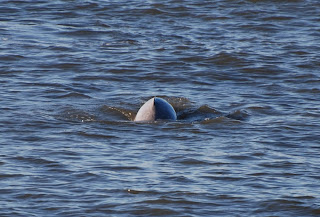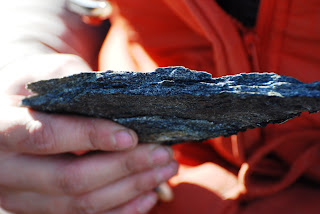Nome does rock, but it also has rocks -- and lots of them! This week I signed up for a geology workshop through University of Alaska Fairbanks, which has a small campus here in town. It was being taught by a grad student who is currently working for one of the gold mining companies, and consisted of an evening in-class session followed by a full-day field trip around Nome.
Basically, without getting too far into the details and vocab that I will probably butcher, the Seward Peninsula is somewhat of a geological phenomenon because it is made up of slightly different terranes (fault-bounded areas with distinct stratigraphy, structure, and geological history) than the rest of Alaska. Some theories even suggest that it might have started as a series of Pacific islands that attached themselves to the mainland. In essence though, the main rocks found here are granite, limestone, schist, and basalt, depending on where you are.
Our first stop was Cape Nome, about 10 miles east of town (where the polar bear was sighted a few months ago). Here we saw examples of granite, which, as a reminder, is the igneous rock with large grains indicative of slow crystallization of magma below the earth's surface.
While we were here, a truck randomly drove up and the driver said he was going to check on his beluga. That immediately piqued everyone's interest, and sure enough it turned out he was a whaler and had caught a beluga in a net strung out from the cape.
 |
| Beluga surfacing |
It appeared there were 2 whales -- one caught in the net, and one swimming around it, although I couldn't tell if I was seeing the same one multiple times. It was kind of sad to see it caught, but knowing that it is simply part of the subsistence lifestyle here kind of softens the reality. Regardless, it was really interesting to see it so close (only about 30-40 feet from shore).
 |
| Dorsal fin |
 |
| Some of the geology class |
Our next stop was further inland to check out some limestone. Unlike the granite, limestone is sedimentary and scrapes into a white powder when you scratch the surface, and can be recognized by its bedding, or layered structure here. Out here it can be a little harder to recognize from afar because of all the lichen that grows on it, making it appear darker and smoother.
 |
| Limestone face |
 |
| Fragment of limestone |
 |
| Brunton demo |
We also got to learn about the strike and dip technique for measuring the orientation of a geological feature. Basically you use a brunton compass and measure the line that joins two or more points of a rock plane at the same elevation (strike), and then the maximum slope of the bed (dip), by turning it perpendicular to the strike.
 |
| Schist fragment |
The third common rock found around Nome is schist, the course grained, flaky metamorphic rock containing quartz, mica, and amphibole minerals. We made two other stops on the field trip -- one to Anvil Peak, and another to the mining claim where our instructor works, to look at more schist and conglomerate formations. Here we also looked at basalt, mica, gneiss, quartz, and garnets. It was a lot information to remember, but overall a good refresher on geology and hopefully I'll be more useful in answering visitor's questions about rocks, next time at work.
And to finish off this post, I'll throw in a few more pictures from around town that have nothing whatsoever to do with geology, but they're pretty anyway. :) Enjoy!
 |
| Sunset over Anvil and the Bering Sea |
 |
| Grass in the breeze |
 |
| Nome sweet Home |
 |
| Sunset behind White Alice |












No comments:
Post a Comment